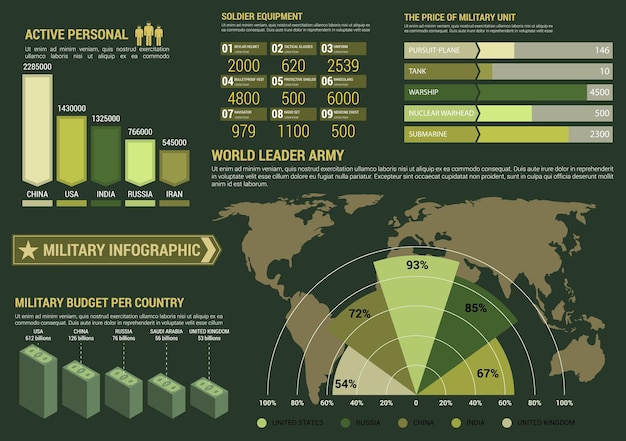US Military Spending: Budget Analysis and National Security Impact

US military spending involves a complex budget allocation process that directly impacts national security strategies, technological advancements, and global influence, necessitating careful analysis of its implications.
Understanding **US Military Spending: Analyzing the Budget and Its Implications for National Security** is crucial for every citizen, policy maker, and global leader. This comprehensive analysis will delve into the intricacies of the US military budget, exploring its allocation, impact on national security, and broader geopolitical consequences.
Understanding the US Military Budget
The US military budget is one of the largest governmental expenditures globally, reflecting its commitment to national defense and international security. Analyzing this budget requires understanding its key components and how it is allocated across different sectors.
Budget Allocation
The US military budget is divided among various branches of the armed forces, research and development, procurement, and other defense-related activities. Each sector plays a crucial role in maintaining the nation’s military readiness and technological edge.
- Personnel Costs: Salaries, benefits, and training for military personnel.
- Operations and Maintenance: Funding for daily operations, equipment maintenance, and infrastructure.
- Procurement: Purchasing new weapons, vehicles, and technology.
- Research and Development: Investing in future military capabilities.

Understanding these allocations provides insight into the priorities of the US military and its strategic focus. For example, a large investment in research and development may indicate a long-term emphasis on technological superiority.
Impact on National Security
Military spending directly influences a nation’s ability to protect its interests and respond to threats. The US military budget is designed to provide the resources necessary for maintaining national security and projecting power globally.
Maintaining Global Power
With a substantial military budget, the US can maintain a strong presence around the world, deter potential aggressors, and respond to crises. This global reach is supported by a network of military bases and alliances.
Deterrence and Defense
A well-funded military can deter potential adversaries by demonstrating its readiness and capability to respond to aggression. It also ensures the ability to defend the nation’s borders and critical infrastructure.
Effective defense capabilities include a strong navy, air force, and army, as well as advanced missile defense systems. Investment in these areas is essential for maintaining a credible deterrent.
Analyzing Key Expenditure Areas
The US military budget dedicates funding to particular areas, each designed to bolster a different facet of national defense. Key areas such as naval strength, cybersecurity, and technology investment are vital to maintaining the country’s strategic advantages.
Naval Strength and Maritime Security
A significant amount of the budget goes towards naval power, which ensures maritime security, protects trade routes, and allows for power projection. The US Navy operates around the world, ensuring freedom of navigation and protecting US interests.
Cyber Warfare and Defense
With the increasing importance of cyber warfare, the US military is investing heavily in cybersecurity capabilities to defend against cyber attacks and protect critical infrastructure. This includes developing offensive and defensive cyber tools.

This investment is vital for protecting government systems, critical infrastructure, and private sector entities from cyber threats. Effective cybersecurity requires a multi-layered approach that includes technology, training, and international cooperation.
The Role of Military Technology
Technological innovation is a critical driver of military power in the 21st century. The US military invests heavily in research and development to maintain a technological edge over potential adversaries.
Advancements in Weapons Systems
Funding supports the development of advanced weapons systems, including stealth aircraft, drones, and precision-guided munitions. These technologies enhance the military’s effectiveness and reduce the risk to personnel.
Technological Superiority
Maintaining technological superiority requires continuous investment in research and development, as well as the ability to quickly adopt and integrate new technologies. This includes artificial intelligence, robotics, and advanced materials.
- Artificial Intelligence: Enhancing decision-making and automation.
- Robotics: Reducing risk to personnel in dangerous environments.
- Advanced Materials: Improving the performance and durability of equipment.
These advancements ensure that the US military remains at the forefront of technological innovation and maintains its strategic advantage.
Geopolitical Implications of Military Spending
US military spending has significant geopolitical implications, influencing relationships with allies and adversaries alike and playing a critical role in global power dynamics.
International Influence
The US uses its military might to exert influence on the international stage, promoting its interests and values. This can involve military alliances, security partnerships, and humanitarian interventions.
Global Power Dynamics
US military spending affects the balance of power in the world, influencing the behavior of other nations and shaping the international order. A strong military can deter aggression and promote stability, but it can also provoke tensions and arms races.
These dynamics require careful management to maintain stability and prevent conflict. Effective diplomacy and international cooperation are essential for mitigating the risks associated with military power.
Economic Impact of Military Spending
Beyond its direct effects on national security and international affairs, US military spending also has a substantial impact on the domestic economy, influencing employment, innovation, and economic growth.
Job Creation and Industry Growth
Military spending can create jobs in the defense industry, supporting manufacturing, research, and development. These jobs provide employment opportunities and contribute to economic growth in certain regions.
Economic Stimulus
Some economists argue that military spending can stimulate the economy by creating demand for goods and services, boosting production, and increasing employment. However, others argue that these resources could be better used in other sectors, such as education and healthcare.
The economic impact of military spending is a complex issue with both positive and negative aspects. Careful consideration of these effects is essential for making informed decisions about budget allocation.
| Key Point | Brief Description |
|---|---|
| 💰 Budget Size | Trillions of dollars allocated annually. |
| 🛡️ National Security | Ensures US defense and global power projection. |
| 🚀 Technology | Drives innovation in weapons and defense systems. |
| 🌎 Geopolitics | Shapes international relations and power balance. |
Frequently Asked Questions
▼
The budget is divided among personnel costs, operations and maintenance, procurement of new equipment, and research and development, each supporting different aspects of military readiness and capability.
▼
High spending is driven by the need to maintain global power, deter potential adversaries, and defend national interests, reflecting the US role as a major global security actor.
▼
Technology is a critical component. Investments fuel advancements in weapons systems, cybersecurity, and intelligence, ensuring a strategic edge over potential threats.
▼
It impacts the economy by creating jobs in the defense industry and stimulating economic growth. However, resources might also be allocated to other sectors for broader economic benefit.
▼
The implications are substantial, influencing international relations, power dynamics, and the US ability to project influence globally, which affects its relationships with both allies and adversaries.
Conclusion
In conclusion, understanding **US Military Spending: Analyzing the Budget and Its Implications for National Security** provides critical insights into the nation’s priorities, strategic objectives, and its role on the global stage. By carefully evaluating budget allocations, technological advancements, and geopolitical implications, stakeholders can make informed decisions that promote both national security and economic prosperity.





